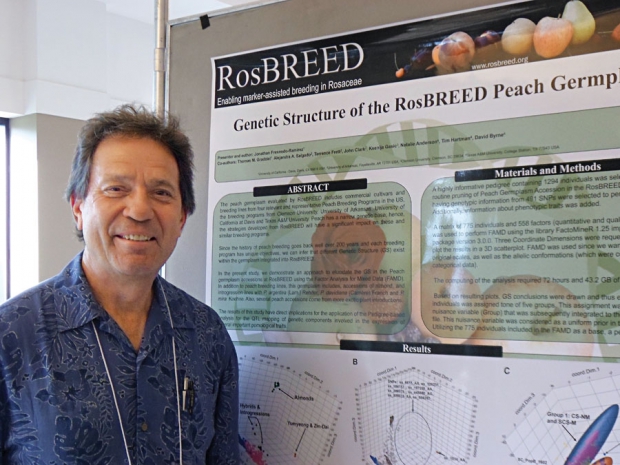
John Clark has been working with “some curiosities” in peach flesh texture, but expects better progress as the texture genetics are worked out. Thanks to new DNA tests, breeders can know flesh texture and other traits before the tree bears fruit. Photo by Richard Lehnert
In the future, peaches may be more like apples—identifiable by variety name—and as different from each other as Honeycrisp is from Granny Smith. They will not be “just peaches” any more.
And the biggest difference may be texture.
The ideal peach may be hard at harvest, resistant to bruising, easy to pick and ship, yet taste sweet and smell good right off the tree. It can be eaten in that crunchy state, which some consumers like. Later, that same peach will melt into the juicy flesh most Americans identify as making a peach a peach.
But several textures are possible.
All this is coming clearer as the breeders involved in the $14.4-million RosBREED project consider what they have learned over the past four years.
Of all the Rosaceae fruits that came together for genetic studies under the RosBREED project, peaches possibly profited the most. In future work, breeders will have a sound footing in the genetics of a broad range of traits, but most especially fruit texture.
“This investment will pay tremendous returns
to plant breeding in the future.”
—Dr. John Clark
For Dr. John Clark, the peach breeder at University of Arkansas, RosBREED provided an opportunity to sort out “some curiosities,” as he called them. Generally, breeders had worked with traits called melting and nonmelting, freestone and clingstone, but they knew there was something else going on.
Now, they know there are genes for other kinds of textures—called slow melting, nonsoftening, slow ripening, and stony hard.
In a presentation last winter at the Mid-Atlantic Fruit and Vegetable Convention in Hershey, Pennsylvania, Clark talked about consumer frustration that is likely responsible for the low level of consumption of peaches compared to other fruits. While nearly everyone loves a perfect peach, “there are a lot of scary peaches out there I don’t want to eat,” he said.
“Since consumer frustrations with peaches often are based on unripe fruit being harvested, resulting in low quality and mealiness, it appears that flesh types that can allow for more mature fruit harvested can have potential,” he said.
Texture in context
In the early 1980s, Clark said, Dr. Fred Hough, the peach breeder from Rutgers University in New Jersey, sent three sacks of seeds from crosses he had made to the University of Arkansas, where Clark had just come on board to work alongside Dr. Jim Moore to breed grapes, blackberries, blueberries, and peaches.
“These populations contributed new genes for flesh types,” he said. “I was not sure what these were, but they were different from the melting and nonmelting flesh types we had been working with.”
One type produced offspring that were freestone but very firm, which then softened when they became fully ripe. These are now called slow melting. Another produced offspring that were clingstone and firmer than nonmelting, having what is now called nonsoftening flesh.
Clark, using traditional breeding methods, was able to release several new varieties with unusual textural qualities.
“I had a hunch something was going on with these flesh types, but did not know what genes were involved, how they were inherited, or how the genes interacted among themselves to produce these differences.”
Enter RosBREED
When the RosBREED project came along, Clark was quick to see the potential, but also realized he was not positioned to capitalize. “I didn’t know nuttin’ about how to do this new technology,” he told his Mid-Atlantic audience about the use of molecular biology and DNA tests.
“Molecular methods allow one to look behind the curtain to see what genes or alleles are present without the confusion of maturity and other factors,” he said. “In theory, it takes the guesswork out of determining what is present or not genetically. It also allows predicting the performance of a seedling way before the tree matures.”
The major focus has been on the endopolygalacturonase molecular marker. The breeders now know that a particular grouping of alleles at that location can produce freestone or clingstone peaches with melting flesh or nonmelting flesh (although nonmelting can be clingstone only). Breeders have long known that melting flesh is a dominant trait. It is still not known what the genetic underpinnings of slow-melting flesh are.
“These flesh types can expand options for harvest maturity and product diversification and can expand the genetic basis in flesh types in ongoing breeding programs,” he said.
While Clark admits knowing very little about the new molecular biology, he figured younger people could master it quickly. So he recruited new graduate students, including Paul Sandefur.
“I came along at just the right time,” Sandefur said. “Dr. Clark was desperate to find someone to work on peaches, the fruit that was most fun to eat and had those amazing flesh types he wanted to characterize. He wanted to uncover the genetics behind textures.”
Sandefur was only a month into his master’s program at the University of Arkansas when the first RosBREED meeting was held in San Diego, California, and Clark asked him to go. That was January 2010. They would meet annually at Michigan State University to review their progress.
Over four years, the federally funded project, coordinated by Dr. Amy Iezzoni, the cherry breeder at Michigan State University, would undertake a coordinated research program with heavy emphasis on sharing new knowledge among breeders of apples, cherries, peaches, and strawberries. RosBREED published 15 newsletters and compiled a body of information that is now available, to breeders and growers, on the www.rosbreed.org website.
Peach solidarity
The peach breeders involved in RosBREED didn’t take long to come together. “It’s incredible how closely the public peach breeders work together,” Sandefur said in an interview with Good Fruit Grower.
RosBREED linked four peach breeding programs: Clark’s at University of Arkansas, Dr. Ksenija Gasic’s program at Clemson University in South Carolina, Dr. Tom Gradziel’s program at University of California, Davis, and Dr. Dave Byrne’s program at Texas A&M University.
Dr. Cameron Peace at Washington State University was the Marker-Assisted Breeding Team Leader who facilitated these strong connections. Sandefur calls him “the bridge,” the person with one foot in the laboratory and one foot in the field, spearheading the links between genetics, genomics, and breeding. Before RosBREED, Peace had already worked to develop what was one of the first fruit quality DNA tests, the endoPG-6 test mentioned previously.
Grad students
Clark says that one of the key contributions of RosBREED was in training what will be the new generation of plant breeders. As the University of Minnesota apple breeder Dr. Jim Luby put it, “The engine of RosBREED has been a cohort of 21 breeding trainees pursuing graduate degrees while embedded in demonstration breeding programs at universities across the U.S.”
Sandefur, of course, is one of those. He is now working on his doctorate at Washington State University, under Dr. Peace. “Dr. Clark wanted me to expand my horizons,” Sandefur said. Raised in Arkansas and taking his bachelor’s and master’s there, he says, “I was drawn to Washington State University, which is on the forefront of new molecular research and has strong industry financial support”—through the $34-million endowment funded by Washington fruit growers.
Another graduate student seeking a doctorate while working on breeding peaches is Alexandra Salgado, from Santiago, Chile, working with Clark in Arkansas on valuable peach traits, including the elusive slow-melting texture.
Also working with Clark is Terrence Frett, who came to Arkansas to work for his doctorate after cutting his teeth at Clemson in Gasic’s program. A fourth is Jonathan Fresnedo, a student from Mexico who is seeking his doctorate while working with Gradziel at the University of California, Davis.
“Without RosBREED, I would not have met Cameron Peace and had the opportunity to finish my graduate work at WSU,” Sandefur said. “I also would not have met the other breeding trainees who I now work with on projects and look forward to working with later in my career.”
“Let me tell you, as we complete the RosBREED project, this aspect of the project has been more than good, it has been outstanding,” Clark said. “I can only comment at this point on the impact of the breeder trainees on the project, but really this is all about an investment in the future, and this investment will pay tremendous returns to plant breeding in the future as the careers of the trainees unfold and their impacts are made.”
Book chapter
Perhaps the biggest feather in Sandefur’s hat is his name in first position on a 60-plus-page paper in the 562-page publication, Volume 41 of Horticultural Reviews. Published by Wiley-Blackwell, Horticultural Reviews has been, since 1979, edited by world-renowned horticulturist Dr. Jules Janick, who has been a Purdue University faculty member since graduating from Cornell University in 1951.
“He was interested in this new information about peach texture, and he approached Dr. Clark and Dr. Peace about it,” Sandefur said. “They said, this is a project for Paul. Again, I was at the right place at the right time.” Sandefur is co-author of the chapter called “Peach Texture,” along with Clark and Peace.
The chapter covers all the information on what are now five flesh types, a section on ripening and enzyme effects on peach texture, and a section that involves growers and their practices.
Production and handling also have effects on peach texture, the writers say—including irrigation, pruning, nutrient management, handling, and cold storage. The major concern is avoiding or limiting mealiness.
“Unlike apples and bananas, peaches are generally not considered a convenient fruit,” the authors write in the peach texture chapter. “The inconvenience of the peach fruit, particularly its soft, easily bruised flesh, short storage life, and high incidence of damage has contributed to its flat consumption rate in recent years.”
Annual per capita consumption of fresh peaches is about 4.5 pounds, compared to about 16 pounds for apples and 24 pounds for bananas.
The results of the RosBREED project, the peach breeders think, will change that.

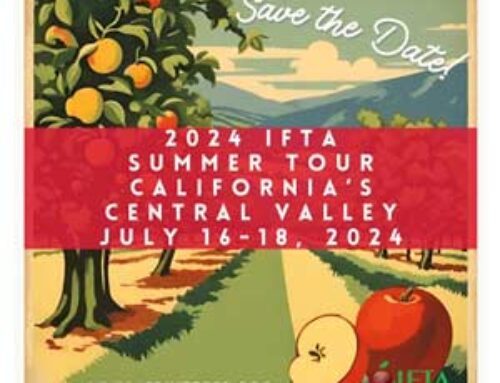
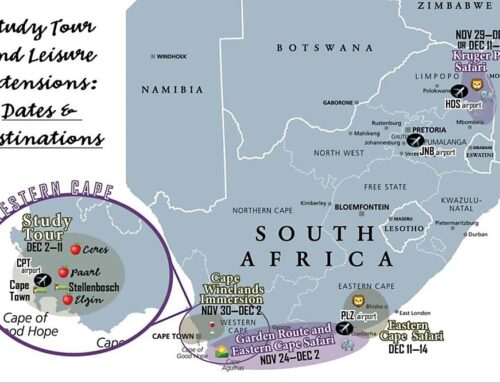
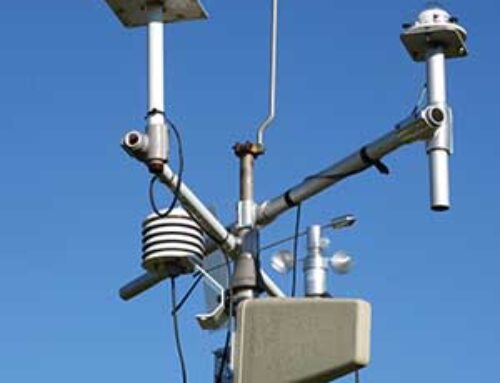
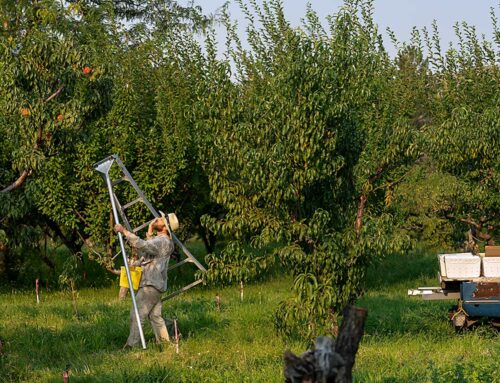
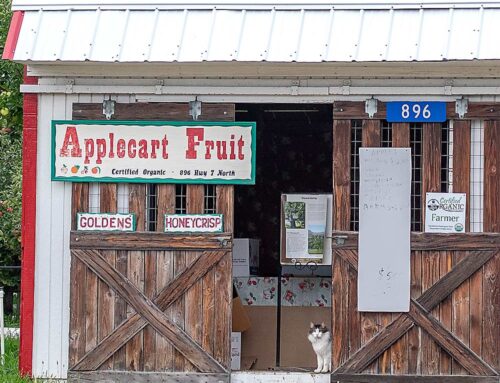
Leave A Comment